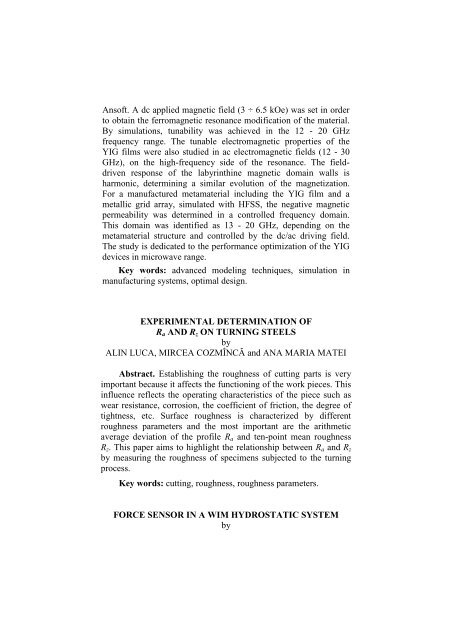buletinul institutului politehnic din iaşi bulletin of the polytechnic ...
buletinul institutului politehnic din iaşi bulletin of the polytechnic ...
buletinul institutului politehnic din iaşi bulletin of the polytechnic ...
Create successful ePaper yourself
Turn your PDF publications into a flip-book with our unique Google optimized e-Paper software.
Ans<strong>of</strong>t. A dc applied magnetic field (3 ÷ 6.5 kOe) was set in order<br />
to obtain <strong>the</strong> ferromagnetic resonance modification <strong>of</strong> <strong>the</strong> material.<br />
By simulations, tunability was achieved in <strong>the</strong> 12 - 20 GHz<br />
frequency range. The tunable electromagnetic properties <strong>of</strong> <strong>the</strong><br />
YIG films were also studied in ac electromagnetic fields (12 - 30<br />
GHz), on <strong>the</strong> high-frequency side <strong>of</strong> <strong>the</strong> resonance. The fielddriven<br />
response <strong>of</strong> <strong>the</strong> labyrinthine magnetic domain walls is<br />
harmonic, determining a similar evolution <strong>of</strong> <strong>the</strong> magnetization.<br />
For a manufactured metamaterial inclu<strong>din</strong>g <strong>the</strong> YIG film and a<br />
metallic grid array, simulated with HFSS, <strong>the</strong> negative magnetic<br />
permeability was determined in a controlled frequency domain.<br />
This domain was identified as 13 - 20 GHz, depen<strong>din</strong>g on <strong>the</strong><br />
metamaterial structure and controlled by <strong>the</strong> dc/ac driving field.<br />
The study is dedicated to <strong>the</strong> performance optimization <strong>of</strong> <strong>the</strong> YIG<br />
devices in microwave range.<br />
Key words: advanced modeling techniques, simulation in<br />
manufacturing systems, optimal design.<br />
EXPERIMENTAL DETERMINATION OF<br />
R a AND R z ON TURNING STEELS<br />
by<br />
ALIN LUCA, MIRCEA COZMÎNCĂ and ANA MARIA MATEI<br />
Abstract. Establishing <strong>the</strong> roughness <strong>of</strong> cutting parts is very<br />
important because it affects <strong>the</strong> functioning <strong>of</strong> <strong>the</strong> work pieces. This<br />
influence reflects <strong>the</strong> operating characteristics <strong>of</strong> <strong>the</strong> piece such as<br />
wear resistance, corrosion, <strong>the</strong> coefficient <strong>of</strong> friction, <strong>the</strong> degree <strong>of</strong><br />
tightness, etc. Surface roughness is characterized by different<br />
roughness parameters and <strong>the</strong> most important are <strong>the</strong> arithmetic<br />
average deviation <strong>of</strong> <strong>the</strong> pr<strong>of</strong>ile R a and ten-point mean roughness<br />
R z . This paper aims to highlight <strong>the</strong> relationship between R a and R z<br />
by measuring <strong>the</strong> roughness <strong>of</strong> specimens subjected to <strong>the</strong> turning<br />
process.<br />
Key words: cutting, roughness, roughness parameters.<br />
FORCE SENSOR IN A WIM HYDROSTATIC SYSTEM<br />
by
















